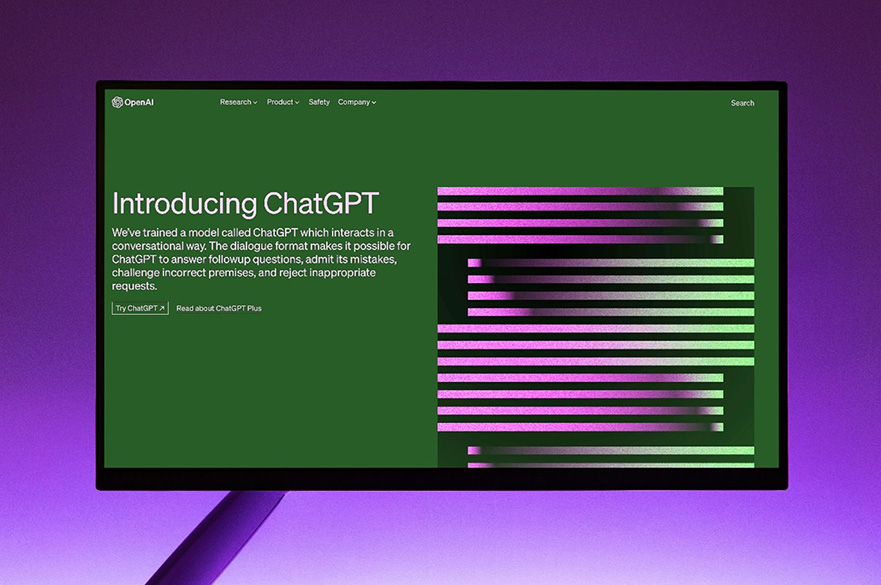ChatGPT as a co-creator in academia – a revolutionary approach
Peter Williams delves into the emergent world of ChatGPT asking how we can use it to create improved learning content.
Please note, the views expressed in this article are the opinion of the author. For NTU policy in this area please see our staff guidance (internal login required).

As you delineate the course objectives, outline the syllabus, and share an intriguing introduction to the subject, you’re high on hopes. But before you know it, there it is – that first glance of lost attention. It happens every year. Everyone knows it – the students, you, and even the walls of the classroom.
It would be easy to point fingers, blame it on a multitude of external factors, but that’s not you. You’re there to help your students lay the foundations of knowledge, even if time constraints make it difficult to cater to all their learning needs in a traditional class setup.
Enter ChatGPT, a potential solution, right? Well, yes and no. It’s complicated, and really, it depends. Here’s the intriguing proposition – let’s explore the role of “ChatGPT as a co-creator.”
It would be naive to expect that the introduction of ChatGPT will liberate you entirely from time commitments. However, once we dive into the dynamics, you will see how it can be an invaluable tool in your arsenal.
Consider the average module stretching across twelve weeks.’ You've already structured your scheme of work and have outlined key weekly topics. Now, you can leverage these planned topics by partnering with ChatGPT.
As a subject specialist, you’re adept at discerning valuable insights. You understand the crucial terms around your subject, something your students are yet to master. So, why not ask ChatGPT, “Give me ten key pieces of terminology around this topic, along with user-friendly definitions that don’t sound like a dictionary excerpt?”
The results can be a goldmine. Not only can you filter the pickles from the cucumbers, but you can also present this information in a more digestible format. A quick video explainer or a narrated PowerPoint presentation can be an effective way to share this information, supplementing their learning outside the traditional class setting.
Want to take it a notch higher?
Use ChatGPT to design a set of multiple-choice questions based on these key terms. Implement these questions on your Virtual Learning Environment (VLE), offering an engaging, interactive way to gauge student understanding.
This approach may garner accusations of being, lazy or even cheating. But consider this. You're going above and beyond to support your students, ensuring they understand the essentials before they even step into your classroom. You're providing a 'flipped learning’ opportunity, checking the content, and using ChatGPT as a co-creator.
Want to take it one step further?
Consider this. You could engage ChatGPT to create scenario-based questions on the key terminology. Or, how about some open-ended questions around the subject matter?
You couldn’t possibly want to do more, right?
Consider extracting the action verbs from your learning outcomes. You might find it helpful to request that ChatGPT provide you with a detailed, step-by-step guide outlining how students could accomplish these outcomes. Additionally, you could ask ChatGPT to generate examples of the type of text your students are expected to submit at various grading levels, to give them a clear understanding of the expectations and differences.
Ok, last one
Perhaps even ask ChatGPT to craft an analogy that your students can relate to, helping them understand complex concepts. How about the analogy is based around the broad subject matter they are interested in. How about the analogy is based around a student's way of life to really ramps up that relatability and context.
Please be warned, ChatGPT can “hallucinate” or “be creative”, which totally depends on your outlook, so checking is fundamental here. You could have fictitious artists, theories, events to contend with. But to be clear what you are doing is not just sorting the donuts from the bagels but also offering your students a rich, diverse assortment of learning resources. You're making use of ChatGPT as a co-creator, revolutionizing traditional teaching and helping your students even more.
If this sounds like too much, start with small steps. Put the outputs it into your lessons as a starter activity, upload your quick questions to something like Vevox, add a plenary open-ended question, or just show generate examples of work you expect to see. Small steps.
In this new age of academia, impress your co-workers by embracing technology to provide unparalleled learning opportunities for your students. Recognize the potential of artificial intelligence in enhancing the learning experience and join the revolution by embracing ChatGPT as a co-creator. Who knows? It might just be the game-changer in your academic toolkit.
Author information
Peter Williams is a Learning Designer with a background in creating visually engaging digital content. With experience in teaching art-based subjects, he brings a creative approach to his work in e-learning design. Reach Peter Williams by email.
More from CADQ blogs
Scaffolding online learning
Barry Gregory delves into scaffolding and explores how we can use this instructional method for designing online courses.
How to approach course design for inter-professional collaborations
Hannah Kingman considers lessons learned from working with the Malaysian Anti-Corruption Commission, which changed the way we worked with professional bodies.
Dual Coding: Exploring opportunities to deliver learning content in NOW
Elena Khabarova considers Dual Coding – the process of combining visual and verbal elements to convey information.